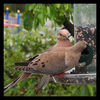willl print paper last?
Jan 26, 2018 08:50:54 #
One minor caveat. I live in southeast Texas where humidity is always an issue. Indoors in A/C in summer, the RH might be 60%, even with the air temp set to 72 degrees. I have found one particular paper from Red River--the pre-scored greeting card stock--does not store well once the seal is opened. After just a few months, it takes on just enough of a curl on the edges that it is no longer suitable for borderless printing or sometimes even within half an inch from the leading edge. Only this style Red River paper and regardless of the finish (glossy, matte, textured). I mention that because that might be an issue with other thick papers in humid environments. Otherwise, I've had no problem with paper from 8.5x11 to 17x25 storing for a long time and still working well with an Epson 3880. I also have inkjet prints (Epson pigment inks) that have been hung on a wall for ten + years with no obvious fading, although they clearly had "out-gassing" for some time after framing, as we've removed some from their frames only to find a film on the inside of the glass. And those prints were aired for a week or more before framing.
Side note. In our old house we had two-speed A/C condensers and variable speed furnace fans. That setup had the ability to dehumidify well, getting summer humidity into the 45% range. New house has builder-grade A/C equipment, and we're back to humidity problems, so I'm looking into a whole house dehumidifier for the system (cheaper than replacing both condensers and both furnaces!)
Side note. In our old house we had two-speed A/C condensers and variable speed furnace fans. That setup had the ability to dehumidify well, getting summer humidity into the 45% range. New house has builder-grade A/C equipment, and we're back to humidity problems, so I'm looking into a whole house dehumidifier for the system (cheaper than replacing both condensers and both furnaces!)
Jan 26, 2018 11:00:27 #
ricardo7
Loc: Washington, DC - Santiago, Chile
ToBoldlyGo wrote:
If you put a little effort into backing up and so on, your digital prints will outlast you any day.
Maybe. As said, I have family photos that were made more than 100 years ago.
At the time, someone saved the pictures in a box where they safely sit today.
Who is going to maintain your image files; backing up, changing file formats or
whatever is needed as the technology changes. Who is going to do that for you
for the next four or five generations?
Jan 26, 2018 11:14:58 #
elf wrote:
I have some print paper in the drawer that is over a year old! Does it go bad?
Tks Ed
Tks Ed
If the paper is archival, and you store it right, it should last. Also, along the same lines, if you still use film cameras, like i do at times, I keep my film stored in the refrigerator. Shelf life is somewhere around 25 to 30 years. Just remember to thaw the film down to regular temp before using. In other words take it out of the frig a day or two before using.
Rich...
Jan 26, 2018 11:39:55 #
ricardo7 wrote:
Maybe. As said, I have family photos that were made more than 100 years ago.
At the time, someone saved the pictures in a box where they safely sit today.
Who is going to maintain your image files; backing up, changing file formats or
whatever is needed as the technology changes. Who is going to do that for you
for the next four or five generations?
At the time, someone saved the pictures in a box where they safely sit today.
Who is going to maintain your image files; backing up, changing file formats or
whatever is needed as the technology changes. Who is going to do that for you
for the next four or five generations?
I don't know and I'm not going to worry about it. I enjoy my photography, I enjoy making scrapbooks with my photos, and I enjoy looking at the photos, sometimes on the computer, sometimes the printed photos.
Having said that, one of my daughters-in-law has asked to have my photo albums "when the time comes."
The other three didn't like that as each album has photos of all four our boys in it.
So, right now, I'm in the process of scanning all photos (or negatives for the ones I still have), put a white strip along the bottom edge of the digital image, and put important information on that: date, location, occasion, people-names. When done, all the photos will go on each of four external hard drives: one for each of the boys.
If they want to pass them on to their children, they can buy more external drives and copy mine to them.
The oldest family photo I have, dates from about 1890, my grandfather with his siblings and parents.
And I have quite a few older photos (that is: pre-dating me!). Even more important I record who's in them and why and when the photo was taken.
Jan 26, 2018 11:58:26 #
ToBoldlyGo
Loc: London U.K.
ricardo7 wrote:
Maybe. As said, I have family photos that were made more than 100 years ago.
At the time, someone saved the pictures in a box where they safely sit today.
Who is going to maintain your image files; backing up, changing file formats or
whatever is needed as the technology changes. Who is going to do that for you
for the next four or five generations?
At the time, someone saved the pictures in a box where they safely sit today.
Who is going to maintain your image files; backing up, changing file formats or
whatever is needed as the technology changes. Who is going to do that for you
for the next four or five generations?
Currently Apple do. If that changes, another online company can take over. Our photos are safe, and if people are worried, the option to print is still there.
Jan 26, 2018 12:05:51 #
elf wrote:
I have some print paper in the drawer that is over a year old! Does it go bad?
Tks Ed
Tks Ed
I used some up a while ago, that was about six years old, looks just like the new one!
Jan 26, 2018 13:01:11 #
mwsilvers wrote:
If printed with an ink jet I'd be more concerned about fading over time.
Office quality dye inks fade fairly quickly. But TRUE photographic quality inks are made with pigments that can last up to 200 years in dark storage or 100 years under glass, displayed indoors.
Conventional, silver halide-based color photographic paper only lasts 20-40 years, by comparison. Black-and-white silver halide papers can last around 100-150 years.
Google Wilhelm Imaging Research for details.
Jan 26, 2018 18:55:10 #
bowserb wrote:
One minor caveat. I live in southeast Texas where... (show quote)
I do not understand how that is possible, because when any AC system cools the air it is no longer able to hold as much water as vapor so the humidity is reduced to whatever level of water vapor that the air can hold at the reduced temperature. What's more the condenser has noting to do with the moisture on the air, all it does is cool the liquid refrigerant and turn it back into a liquid. if anything would affect it, it would be the evaporator, but that is not how it works. It sounds to me like possible your system is bringing outside air into your home so rather than circulating the same air which would lower the relative humidity because it cools the air to a temperature that is lower than the room temperature so when it leaves the evaporator it has a lower humidity level that the air in the room is able to hold. I am not that familiar with residential AC systems, but in larger systems there is damper that that controls how much outside air is mixed with the inside air before it travels through the evaporator. You might want to check to see if your system has one and if it does it may stuck wide open. That's why it is called an air conditioner and not an air cooler. Is there any chance that you have a swamp cooler and not an air conditioner at all. Having variable speed fans would not have any effect on how much humidity is left in the air.
Jan 26, 2018 19:50:56 #
nauticalmike wrote:
I do not understand how that is possible, because ... (show quote)
Wrong forum for AC talk. What little I know I learned from a Houston A/C guy who pioneered some features that are standard in residential air systems, for the five years I maintained their website...and from my son in law who is also in the AC business. The two speed compressor works in conjunction with a low speed fan to continue removing moisture from the air after the target temp has been achieved. Because humidity is so high throughout the spring summer and fall, an AC unit running full speed can get the air temperature down to the setting without running long enough to remove sufficient humidity. Therefore it might be 72 degrees and still be uncomfortable, due to high humidity. Turn down the thermostat to, say, 70, and it gets cooler but with humidity still sitting around 60% or so, it can feel cool and damp. That's where the two speed (or even newer units from Amana which can run slower) a compressor running at 20% capacity and a slow running furnace fan will not bring the temperature down much, but it will continue to remove moisture from the air. I've seen it in action. My son in law replaced the single speed Trane units outside with two speed American Standard condensers (OK compressor-condenser units) and Amana furnaces with variable speed fans. The thermostats have settings for temperature and relative humidity. So often when the set temp was reached, the compressor would continue running at low speed, and the fan continued running at a lower speed also. Occasionally that would bring the temperature down another degree below setting, but usually not, but the humidity would finally reach our setting--usually 40-45%. End result was greater comfort at higher room temperature, thanks to the low humidity. Maybe you have to have lived in Gulf South to really appreciate the impact of perpetual high humidity. I saw the change at our old house, and indeed, we also had lower electric bills, and those huge American Standard compressor-condenser units helped sell the house, when we moved.
Note. Our old house, built in 1990, did not have fresh air intake. The new house does. The air intake is only on the downstairs unit and is set to be open 20% of the time the unit is running, or it can be opened and run on demand. This is doubtless a factor here, but it is not the whole story. And swamp coolers? Maybe in El Paso, but not here.
Jan 26, 2018 22:52:14 #
TucsonCoyote wrote:
In Photography "Print Paper" used to mean something totally different than what
you are talking about here I think !

you are talking about here I think !


That's what I thought the OP meant! >ALan
If you want to reply, then register here. Registration is free and your account is created instantly, so you can post right away.



